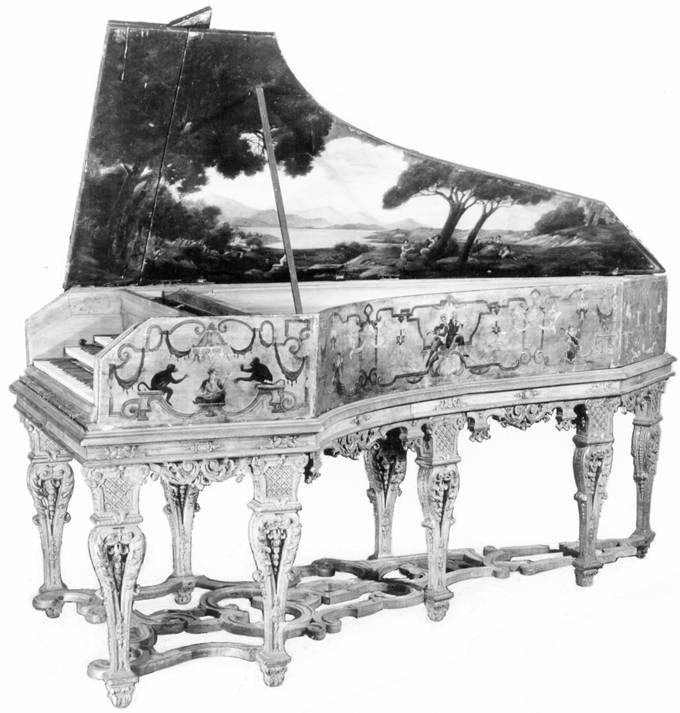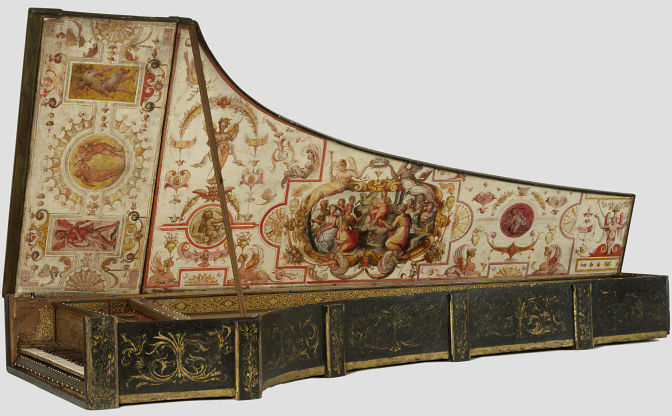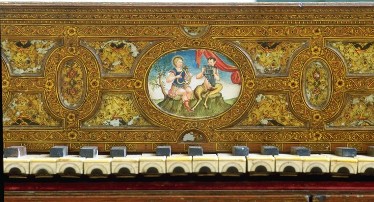Giovanni Baffo Harpischord, 1574, Venice
Pine case, inner face veneered with rosewood, partly inlaid with boxwood; cypress soundboard
This harpsichord was built by Giovanni Baffo, the leading maker of harpsichords in Venice, one of the main instrument-producing centres in Europe during the 16th century. The instrument is decorated with traditional Islamic patterns, then widely used in Venice, and also fashionable classical motifs, such as Apollo and the Muses, a suitable theme for musical instruments. National Art Library at the Victoria
and Albert Museum. http://collections.vam.ac.uk/item/O58982/harpsichord-baffo-harpsichord/
 Celestini harpischord, 1594
Celestini harpischord, 1594... a giant Venetian harpsichord, one of the few remaining by Giovanni Celestini, dated 1594. One year's carefull research unravelled its complicated life history. It was bought by the Medici at the end of the 17th century, and worked on by Cristofori, and by one or more of the Ferrini's, who were Cristofori's successors .Due to the fame of its maker, its large size and precious decoration, it was perhaps the most prestigiuos keyboard instrument in the Medici collection. www.gb.early-keyboard.com/
The below historical information is from Wiki Visual viewed on May 10, 2010. http://en.wikivisual.com/index.php/Harpsichord
Images are from sources as noted
" History
The origin of the harpsichord is obscure, but is known to have begun some time during the high or late Middle Ages. The earliest written references to the instrument date from the 1300s and it is possible that the harpsichord was indeed invented in that century ... A Latin manuscript work on musical instruments by Henri Arnault de Zwolle, c. 1440, includes detailed diagrams of a small harpsichord and three types of jack action.
....
Italy
The earliest complete harpsichords still preserved come from Italy, the oldest specimen being dated to 1521. The Royal Academy of Music in London, has an instrument of a curious upright form, which may be older; unfortunately, it lacks the action. These early Italian instruments can however shed no light on the origin of the harpsichord, as they represent an already well-refined form of the instrument. The Italian harpsichord makers made single-manual instruments with a very light construction and relatively little string tension. This design persisted with little alteration among Italian makers for centuries....
....
England
The harpsichord was important in England during the Renaissance for the large group of major composers who wrote for it, but apparently many of the instruments of the time were Italian imports. Harpsichord building in England only achieved great distinction in the 18th century with the work of two immigrant makers, Jacob Kirckman (from Alsace) and Burkat Shudi (from Switzerland). ..."
Harpischord made by Jerome of Bologna, 1521, Rome.
Cypress case and soundboard, with decorative stringing, gilding and inlay
This harpsichord was made in Rome in 1521 by Jerome of Bologna. Although almost nothing is known about its maker, this example is one of the earliest dated keyboard instruments to survive. National Art Library at the Victoria
and Albert Museum. http://collections.vam.ac.uk/item/O58980/harpsichord/

Harpsichord by Andreas Ruckers the Elder, Antwerp, 1607.
The earliest known dated harpsichord by Andreas Ruckers. Rose with "AR" flanking a harp-playing angel; soundboard with painted decoration including the date "1607"; although the case was redecorated during the 18th and/or 19th century, it is essentially unaltered, retaining its original dimensions, internal construction, bottom board, and tool compartment with a door in the spine. The original bridges, nuts, and key frame were retained in the petit ravalement during which the keys and action were replaced. The date "12 octobre 1757" is written on the key frame. National Music Museum, University of South Dakota-Vermillion, http://orgs.usd.edu/nmm/Ruckersphotos.html
 Three-manual harpsichord by Stefano Bolcioni, Florence, 1627
Three-manual harpsichord by Stefano Bolcioni, Florence, 1627Russell Collection of Early Keyboard Instruments
http://www.claviantica.com/Publications_files/Russell_Collection_Italian_instruments_files/Russell_Collection_Italian_Instruments_Bolcioni_files/Bolcioni_3-4.jpg
Early Italian harpsichord
A fine example of an early Italian harpsichord
Made in Florence, circa 1640
51 keys: 2 × 8’; C to d3
Early Italian harpsichord
A fine example of an early Italian harpsichord
Made in Florence, circa 1640
51 keys: 2 × 8’; C to d3
"The advent of the C-30 digital harpischord", Roland Corp. http://www.roland.com/classic/c30/meet/index.html
 Harpsichord by Andreas Ruckers, Antwerp, 1643. "Although, by the beginning of the 19th century, harpsichords went out of fashion as instruments for contemporary music making, they soon were collected as aristocratic pieces of furniture reminiscent of the glories of the past. The plain painted surfaces of harpsichords like the 1643 Ruckers were deemed insufficiently ornate for the pseudo-historical fantasies of 19th-century interior decoration, so its exterior surfaces and the area around the keyboard were redecorated with elaborate borders, vignettes, and garlands on a gold ground. A flamboyant gilt carved stand was also provided. Anachronistic though this redecoration may be, it was responsible for the preservation of the harpsichord until it could again be appreciated as a musical instrument.
Harpsichord by Andreas Ruckers, Antwerp, 1643. "Although, by the beginning of the 19th century, harpsichords went out of fashion as instruments for contemporary music making, they soon were collected as aristocratic pieces of furniture reminiscent of the glories of the past. The plain painted surfaces of harpsichords like the 1643 Ruckers were deemed insufficiently ornate for the pseudo-historical fantasies of 19th-century interior decoration, so its exterior surfaces and the area around the keyboard were redecorated with elaborate borders, vignettes, and garlands on a gold ground. A flamboyant gilt carved stand was also provided. Anachronistic though this redecoration may be, it was responsible for the preservation of the harpsichord until it could again be appreciated as a musical instrument.




Respect and I have a nifty present: What Home Renovation Shows Are On Netflix 1970's split level remodel
ReplyDelete